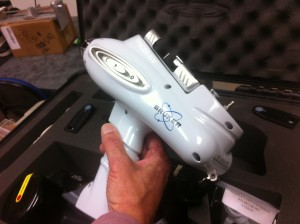The chemistry department’s recent purchase from The Metropolitan Museum of Art will put X-ray technology into students’ hands this semester.
The refurbished, handheld XRF spectrometry instrument detects which elements are present in artwork and artifacts, helping scientists date and pinpoint the origin of the artwork. Chemistry professor Gary Mabbott was involved with purchasing the device.
“The idea is to be able to identify metals and quantify them,” Mabbott said. “You can tell copper apart from zinc apart from iron or nickel, and it makes it a good way to identify things.” 
Mabbott said before the department can get the X-ray instrument up and running, there are a few preliminary steps to take, such as bringing in personnel from X-ray company, Bruker for a training session. Mabbot said he hopes to have students using the device by midterm break.
“You just don’t give anyone on the street your keys to the Mercedes. So you want to make sure they know how to drive and how to work with it safely,” Mabbott said.
Among other operations, Mabbott said the instrument can be used to look at pottery or other pieces of art to decipher where they came from.
“(If art pieces are typically) found at this particular part of the world but then they’re found elsewhere … there must have been some trade involved, so there’s all kind of interesting stuff you can find out about materials just based on the elemental composition,” Mabbott said.
The elemental composition can also help people determine if a piece of artwork is an original piece or a copy.
“Is this really a painting by Van Gogh? Well, it should only contain paints that he had available to him at the time and was known to use,” Mabbott said. “So we can look at the pigments and look at the metals that were involved and say ‘OK, he had ahold of that kind of paint.’”
Although similar devices are popular among the geology community in many universities, Mabbott said St. Thomas’ chemistry department is a pioneer for bringing in the instrument for chemistry purposes.
X-rays have been used for analysis before, but the instrument’s portability is a new feature. Sophomore chemistry major Cecilia Gentle said she especially likes that the instrument is easy to use.
“I think it’s really cool,” Gentle said. “It’s a handheld device, so we’ll be able to do lots of hands-on activities and take it places.”
Mabbott said the chemistry department has been looking to purchase the instrument for a couple years and available money in the chemistry department’s budget made it possible. The X-ray currently is kept in Owens Science Hall.
Gentle said she is excited about the chemistry department’s newest addition.
“I think it was a really good purchase,” Gentle said, “(With some chemistry equipment) you have to take the sample to the instrument, you can’t take a giant instrument out into an art museum. It’s cool that is has the mobility. That is kind of a unique thing that a lot of instruments in the chemistry department can’t do.”
Because of its versatility, Mabbott said chemistry students will be able see the device in use in the classroom, and some chemistry students will be eligible to use the device for research projects independently.
Sophomore chemistry major Jake Held said he’s looking forward to using the X-ray instrument for research projects down the road.
“I’m really excited, and I can’t wait to start using it. I hope to use it over the summer for a research project,” Held said.
Gentle said she is most excited to learn across subjects with this instrument.
“For me, I always think it’s super fun to connect art and chemistry, because nobody thinks they are related,” Gentle said. “So if there’s ways to take this (instrument) and show people, hey you can apply it to art. It’s two fields that nobody puts together and also bring together students.”
Stephanie Dodd can be reached at dodd0474@stthomas.edu.

